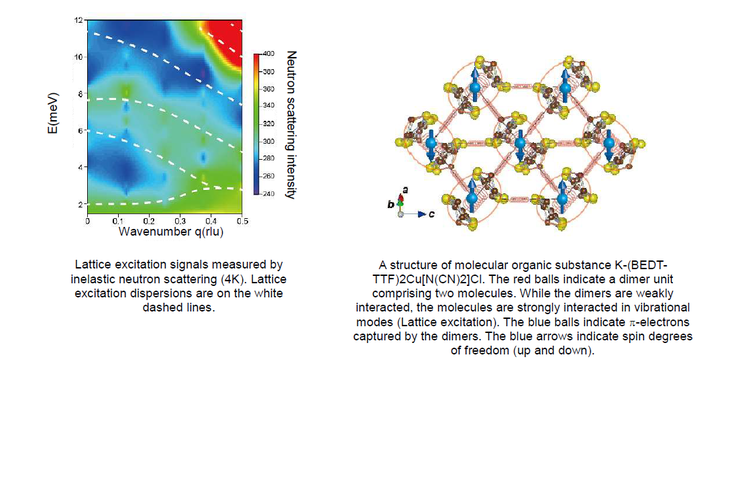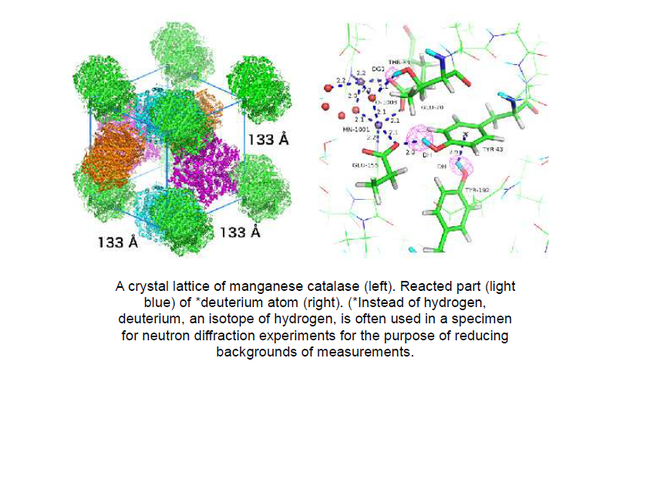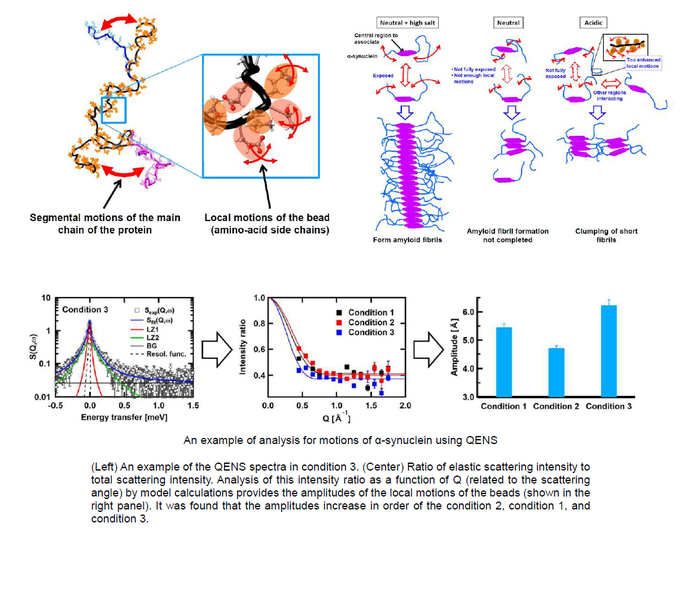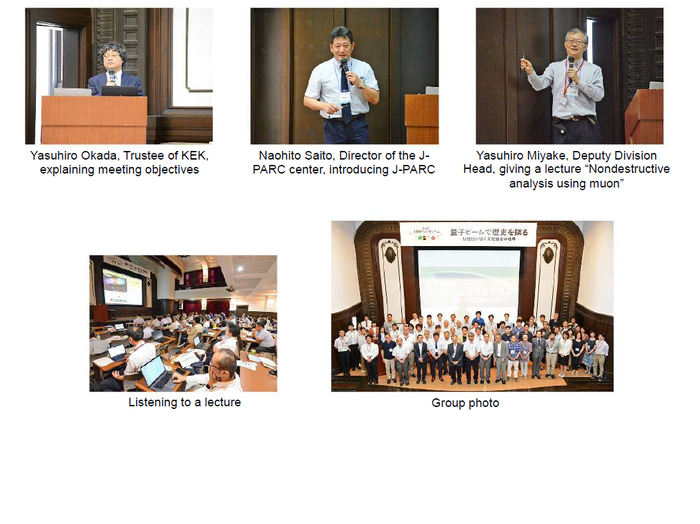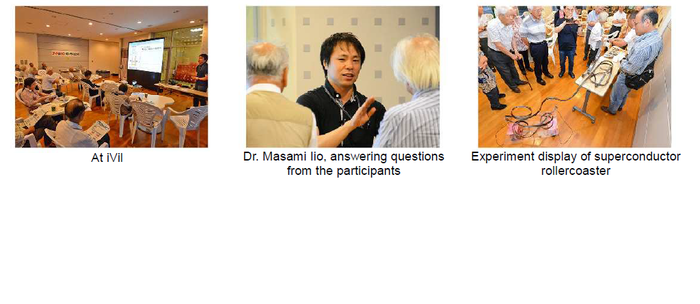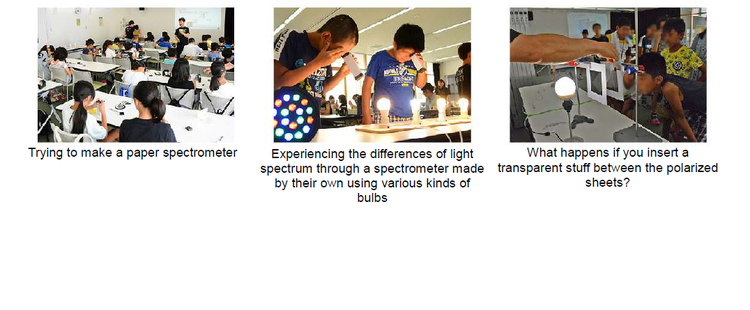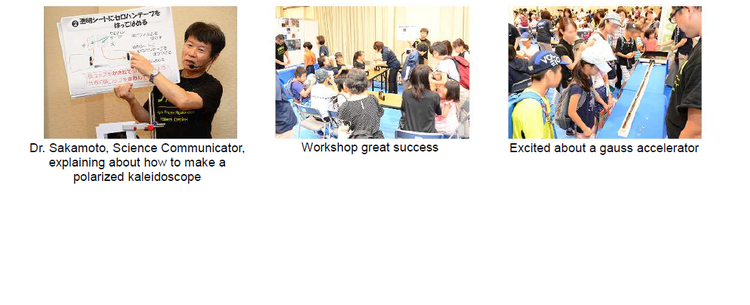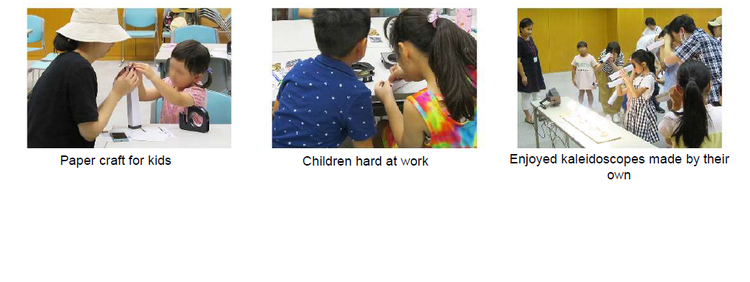J-PARC NEWS August 2019 (Issue #172)
■ J-PARC Center Director Signs Cooperative Agreement with DOE Director (August 7, Ministry of Education, Culture, Sports, Science and Technology (MEXT))
The J-PARC Center has concluded a new cooperative agreement with the Oak Ridge National Laboratory (ORNL) science and energy laboratory of the US Department of Energy for the purpose of boosting collaboration for high-power spallation neutron source development and related fields. A signing ceremony was held at MEXT on August 7, with DOE Director Christopher Fall and J-PARC Center Director Naohito Saito both signing documents for the cooperative agreement. Prior to the signing ceremony, Director Fall visited J-PARC and JRR-3 on August 5, and was provided with an explanatory overview of J-PARC by the Director. This was followed by an intensive tour of the LINAC, Materials and Life Science Experimental Facility, Neutrino Experimental Facility and Hadron Experimental Facility where he communicated with researchers and other staff there.
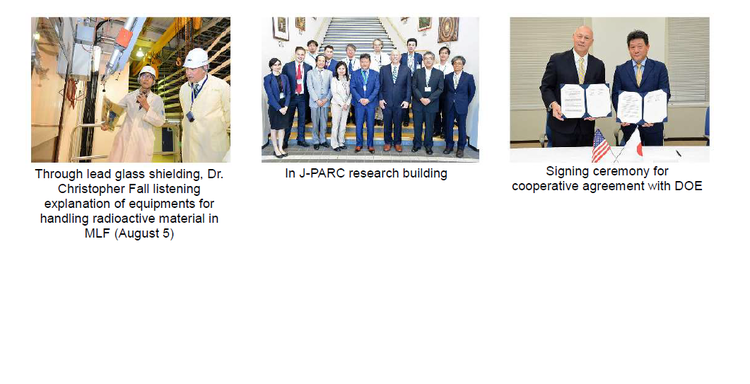 ■ J-PARC Concludes Collaborative Agreement with European Organization for Nuclear Research (CERN) (July 29)
■ J-PARC Concludes Collaborative Agreement with European Organization for Nuclear Research (CERN) (July 29)
The J-PARC Center and the European Organization for Nuclear Research (CERN) have cooperated with the exchange of personnel, information and technical data as well as exchange and supply of test materials for high intensity proton accelerators with the aim of increasing the performance of each of their respective accelerators. In addition to cooperation for enhancing LINAC performance from around 2007 and the development of accelerating cavities from around 2010, vigorous cooperative research of materials development and mechanical engineering required for increasing the performance of the beam dump and target beam window collimator that collects high-intensity beams has carried out from around 2015. A second revision has now been made to an agreement concluded in 2011 to further expand the scope of all-inclusive cooperation of both organizations for R&D into equipment collecting these high-intensity beams and clarifying the technical cooperation related to the design, operation and maintenance of facilities where targets are installed. The revision to this agreement officially came into effect on July 29 with the signing by J-PARC Center Director Naohito Saito.
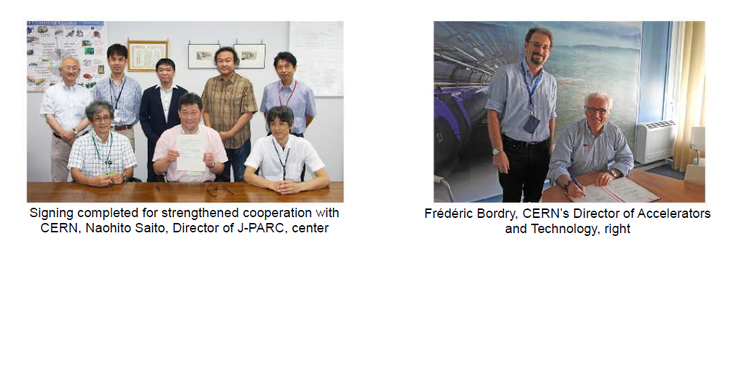 ■ Discovery of lattice excitation associated with electronic ferroelectricity – Enhanced research into inelastic neutron scattering of molecular organic charge transfer salts – (August 8, press release)
■ Discovery of lattice excitation associated with electronic ferroelectricity – Enhanced research into inelastic neutron scattering of molecular organic charge transfer salts – (August 8, press release)
Research into the cause of electronic ferroelectricity (which is a new class of ferroelectrics of purely electronic origin) of κ-(BEDT-TTF)2Cu[N(CN)2]Cl, a type of molecular organic substance, has revealed new functionalities related their electrical properties, such as undergoing large changes with smaller amounts of pressure or light compared to inorganic compounds, and is an important field of basic research. This substance is a dimeric compound where two molecules form a single unit, with both molecules having a strong bond but with a relatively weak bond between units. This causes vibrations in the form of waves (lattice excitation) that propagate throughout the substance. In order to reveal anomalies in the lattice excitations coupled to the microscopic electric polarization, the research team have performed inelastic neutron scattering experiments by using equipment at ILL*1 and FRM2*2. The results indicate that lattice excitation signals observed around 2.6 meV at temperature 4 K*3 as shown in the image had a significantly wide energy spread at temperatures 60 K to 27 K corresponding to abnormal decay in the lattice excitation. The lattice excitation is closely related to the movement of pi electrons, and the observation of lattice anomalies coupled to the spin of pi electrons suggest the presence of microscopic fluctuations in electric polarization caused by those pi electrons. Measurements of the crystal structure made using J-PARC’s single crystal neutron diffractometer called SENJU, revealed that the dielectric properties could not be attributed to the shifts in the lattice position, but instead due to pi electrons. The success of these neutron scattering experiments using a single crystal sample of only 10 mg in size will lead to more experiments on molecular organic substances in the future, and will further advance research into lattice excitation linked to a diverse range of properties. For further details, please see the following page. https://arxiv.org/abs/1906.08590
*1 Institut Laue-Langevin, France
*2 Forschungs-Neutronenquelle Heinz Maier-Leibnitz, research reactor, Germany
*3 K (Kelvin) = ℃ +273.15
■ Successful neutron structural analysis of proteins with the largest lattice volume – Managed to observe hydrogen atoms in even larger proteins with the IBARAKI Biological Crystal Diffractometer (iBIX) – (August 23, press release)
The IBARAKI Biological Crystal Diffractometer (iBIX) installed at the J-PARC Materials and Life Science Experimental Facility (MLF) is a neutron diffractometer capable of analyzing the structure of large protein crystals comprised of unit cells (repeating unit in a crystal) with a length (lattice length) of 135 Å (= 13.5 nm) along each of the three sides. As the unit cells of crystals increase in volume, the number of diffraction points from the crystal increase and cause overlaps, the number of unit cells in the crystal being measured decreases, and the diffraction intensity becomes smaller, all of which make obtaining high-precision data more difficult. A new type of software was thus developed to calculate based upon each overlapping point of diffraction, and analysis of neutron crystal structure performed on manganese catalase derived from the extremely thermophilic bacterium Thermus thermophilus HB27 which has a large crystal lattice volume and a lattice length, which is closed to the designed maximum limitation of iBIX target value. As a result, hydrogen atoms bonded with the protein were successfully observed and the objective was verified and achieved. The volume of the crystal lattice (2373 nm3) was more than double that of some 150 types of proteins with the largest lattice volume (913 nm3) that had been structurally analyzed to date using neutrons. If the output of the J-PARC accelerator reaches the rated 1 MW, which is approximately 6-times the 150 kW output at the time of the experiment, the total 12 days measurement time required for this experiment is expected to be shortened to around 2 days. These results highlight the vast potential of neutron structural analysis of proteins that were not possible with conventional neutron diffractometers, and is expected to further advance basic research such as clarifying the role of hydrogen atoms in many types of enzymes and observing hydrogen atoms that are vital for mutual interaction between protein complexes. The results also show promise for other contributions like the development of enzymes for industrial use and the design of pharmaceutical supplies.
■ Movements in proteins cause you illnesses – Successfully observing molecular motions of proteins that cause Parkinson's disease – (August 26, press release)
The mechanism that causes Parkinson's disease is thought to be closely associated with aggregation of normal “α-synuclein” protein within the brain to form abnormal “amyloid fibrils”. Proteins are made up of a string of amino acid beads connected together in a long chain-like structure. A detailed study of the segmental motions (such as bending and stretching) of the chain and local motions of the beads of α-synuclein on a molecular level is essential to clarify the way these amyloid fibrils are formed. This research mainly involved measurements in quasi-elastic neutron scattering experiments using J-PARC’s Biomolecular Dynamics Spectrometer (DNA), and revealed for the first time the segmental motions of the chains and the local motions of the beads simultaneously. Measurements were performed for three different conditions where α-synuclein forms amyloid fibrils (neutral with a salt concentration close to the physiological concentration: condition (1)), where fibril formation of α-synuclein is not completed (neutral with no salt: condition (2)), and where clumping of short fibrils of α-synuclein occurs (acidic: condition (3)). As a result, the local motions of the beads were observed to enhance in order of (2) -> (1) -> (3), indicating that the local motions of the beads are necessary for interactions between the α-synuclein molecules. On the other hand, the segmental motions of the chains were largest with (1) and smallest under the other two conditions, suggesting that the segmental motions of the chains is essential for the formation of amyloid fibrils. The amyloid fibrils are known to form by association of the central regions in α-synuclein. The above results suggest that at first the local motions of the beads are required for the mutual interactions between the molecules, then the segmental motions of the chains exposes the central regions, which allows them to associate together. These results should help clarify the mechanism underlying the formation of amyloid fibrils. Hopefully, this study will lead to a new approach of drug development, based on a principle that the functional and/or structural aberrations can be prevented by controlling the protein motions, in the future.
■ J-PARC Open House 2019 (August 25, J-PARC)
J-PARC Open House was held in great weather on August 25, with 1,500 visitors—many more than last year—attending the event. Visitors had the chance to tour the accelerator, Hadron, neutrino and other facilities located in the underground tunnel opened especially for the event. J-PARC Center Director Naohito Saito also gave a commemorative speech to celebrate J-PARC’s 10th anniversary, and a particle salon, mini lectures and a number of other programs gave visitors the opportunity to get up close with the world of science. Hands on workshops for playing with light kaleidoscopes, spinning tops to learn about spinning, color-changing bead straps, super balls, slime and many other items were very popular, with many families having fun making their own items and discovering new things. Tokai-mura Mayor Yamada also visited on the day, and Director Naohito Saito provided explanations and accompanied him on a tour of the MLF facilities.
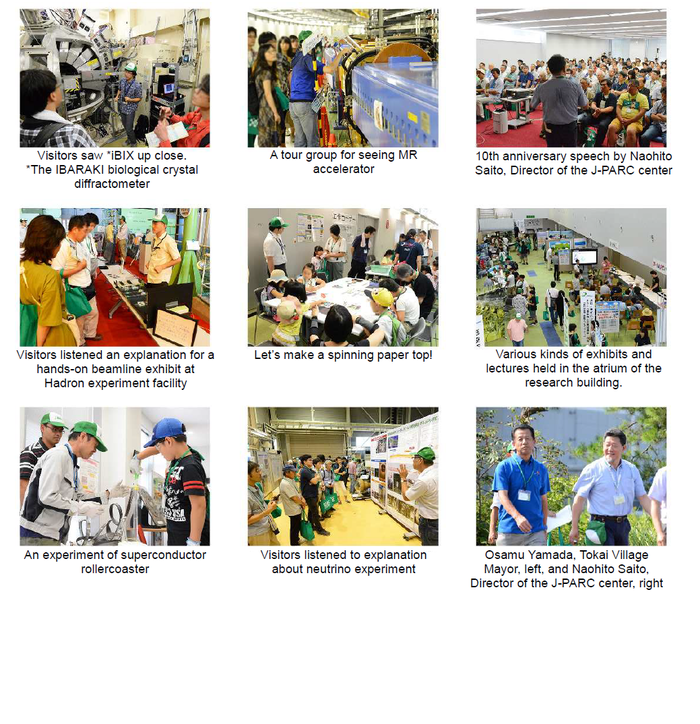 ■ 1st Symposium on Exploring History with Quantum Beams – Where Accelerators are Bringing Humanities and Science Together (July 27 to 28, National Museum of Nature and Science, Ueno, Tokyo)
■ 1st Symposium on Exploring History with Quantum Beams – Where Accelerators are Bringing Humanities and Science Together (July 27 to 28, National Museum of Nature and Science, Ueno, Tokyo)
The 1st Symposium on Exploring History with Quantum Beams was held over two days from July 27 to 28 at the National Museum of Nature and Science in Ueno, Tokyo as part of a joint event organized by the KEK Institute of Materials Structure Science and the National Museum of Nature and Science of the National Institutes for the Humanities. Non-destructive measurement for research of cultural properties in the past used to involve radiation light, neutrons and other means, however in recent years the use of negative muon beams of the Muon Instruments (MUSE) at MLF has increased. Materials and Life Science Division Deputy Manager Yasuhiro Miyake (KEK Professor) and Mr. Takenao Shinohara of the Neutron Source Section each gave lectures titled “What are Muons! – Non-destructive analysis using Muons –“ and “Imaging Technologies using Pulsed Neutrons.” Many case studies of non-destructive measurements using quantum beams by researchers of humanities and natural sciences at universities, museums, research laboratories and other facilities around Japan were presented. The lectures also explored the potential of muons by discussing the planned analysis of rock samples acquired by the “Hayabusa 2” spacecraft.
■ 31st J-PARC Hello Science Realm of Low Temperatures – Low-temperature Technologies Supporting Advanced Science – (July 26, Tokai-mura Industry and Information Plaza “iVil”)
There are many strange phenomena that exist in the realm of low temperatures, like superconductivity as electrical resistance drops to zero when substances are cooled, and superfluidity as the fluidity of liquid helium increase at ultra-low temperatures. Accelerator facilities at J-PARC and around the world are utilizing these phenomena to conduct advanced research. The Hello Science event held every month at iVil has twice featured the topic of “Superconductivity,” with Masami Iio and team from the J-PARC Center Low-Temperature Section giving a lecture and demonstrations of superconductivity. This month, Mr. Iio talked about the “Realm of Low Temperatures” that gives rise to this superconductivity, and explored topics ranging from easy-to-understand thermodynamics—what happens when objects are heated or cooled—to the methods used to create low temperatures, and explanations of the principles and technologies behind them. An experiment was then conducted to show the expulsion of the magnetic flux within a superconductor as its temperature decreases, and he demonstrated this by using the Meissner effect floating above a magnet. He explained how pushing a superconductor against a magnet forces part of the magnetic field inside and keeps the superconductor and magnet locked in the same position, which can be used as a sort of fastening pin to keep them in place even when turned upside down. Visitors were then invited to check out the “superconductor rollercoaster,” which used these effects to allow a superconductor to float above a twisted rail made up of small magnets without falling off. He finished up by talking about the latest advances in superconductor technology and how they are used throughout the medical and transportation sectors.
■ Outreach Activities (July to August, Tokai Library, Oarai Wakuwaku Science Museum, Ministry of Education, Culture, Sports, Science and Technology (MEXT) in Kasumigaseki)
The J-PARC Center is running its “J-PARC Hello Science” program aimed at getting more children involved in science events and developing an interest in science. Activities mainly involve the Public Relations Section Science Communicator Shinichi Sakamoto going on school visits, running hands-on workshops and organizing other events. From July to August, he organized the “Summer Holidays Science Workshop” held at Tokai Library four times (July 31, August 9, 21, 27), the “Simple Crafts” held at Oarai Wakuwaku Science Museum on August 3, and the “Summer Holidays Kids Kasumigaseki Open Day” held at MEXT on August 7 and 8. Features and activities included a scale model of J-PARC, posters highlighting the facilities and research results, demonstrations of a gauss accelerator that accelerates particles using magnets, workshops on the science of colors, and making kaleidoscopes to help learn about spectroscopy and polarization. The children taking part in the events looked so keen and had a lot of fun learning about science.
● J-PARC Hello Science Summer Holidays Science Workshop “Colors, So Strange! The Science of Colors” (Tokai Library, July 31, August 9, 21, 27)
● Color Kaleidoscope! “Simple Crafts” J-PARC Hello Science (Oarai Wakuwaku Science Museum, August 3)
● “Summer Holidays Kids Kasumigaseki Open Day” J-PARC Hello Science (MEXT, August 7, 8)

